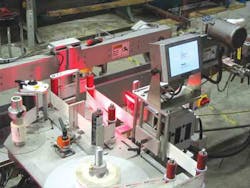Labeler Loads Up on Pharma Tech
The Model SM 9000 ACLS label application machine from SPS/PHIN Limited (www.spsphin.com), integrates three subsystems—printing, optical character verification, and label inspection—in one machine frame. For the simplest of these subsystems, label-presence inspection, SPS/PHIN sought a solution that would not only provide simple setup and pass/fail output like a traditional sensor, but also offer flexibility to ease changeovers for performing inspections on a wide variety of products. The search led the firm to choose the Cognex (www.cognex.com) Checker inspection sensor. Checker replaces multiple photoelectric sensors and can detect features that conventional sensors cannot. “Checker is also less costly than a machine vision system and more reliable than a conventional sensor,” explains SPS/PHIN technician John Sadkowski. “It’s working great in this application.”Checker’s high-speed operation allows it to capture a half-dozen images of each passing bottle. By analyzing views from different perspectives, Checker achieves high inspection reliability compared to other inspection sensors. Another attractive Checker feature, says Sadkowski, is that it includes programmable logic controller-like capabilities and directly accepts encoder input to inspect, track, and reject items on variable speed packaging lines, all without a PLC. “Checker is much easier to work with for new products, and it has more options,” Sadkowski explains. For example, multiple sensor set-ups are selectable by discrete inputs. This helps with fast line changeovers, which is a key benefit for contract packagers. The operator interface for the SM 9000 labeling system is a GE Fanuc (www.gefanuc.com) touchscreen that displays soft keys to call up various Checker setup files for whichever product is running.“We use the same PC that runs the Cognex optical character verification system to communicate with Checker,” Sadkowski explains, “but if we had no PC, Checker can run standalone. So it’s a versatile device because it has a built-in processor.” The PC is a standard, consumer-level personal computer.“We can use Checker in many different ways. It includes automated changeover functionality. It’s much simpler to integrate and more cost efficient compared to a complete vision system. So in the future, when we have a presence sensing application, we will use a Checker,” concludes Sadkowski.The SM 9000's functions are run by a Rockwell Automation (www.rockwellautomation.com) Allen-Bradley MicroLogix 1200 programmable logic controller. The labeler is also designed with two Allen-Bradley Ultra 5000 servo drives from Rockwell.Date and lot codes are printed by a pair of redundant Videojet (www.videojet.com) DataFlex Plus thermal-transfer printers. The units are said to offer high reliability and simple operation for high-resolution coding on flexible packaging and labels. “When one runs out, the other automatically kicks right in,” says Sadkowski. After printing, the preprinted and on-line printed information is verified by an optical character verification system provided by Cognex that uses its OCV/OCR (recognition) software in conjunction with one third-party video camera per printer.The labeler was installed at a pharmaceutical customer site in Canada in September 2006.

